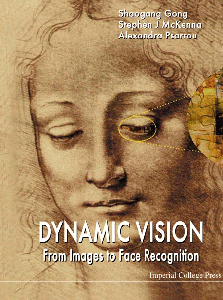Dynamic Vision:
From Images to Face RecognitionShaogang Gong
Stephen McKenna
Alexandra Psarrou
Preface
Face recognition is a task that the human vision system seems to perform almost effortlessly, yet the goal of building computer-based systems with comparable capabilities has proven to be difficult. The task implicitly requires the ability to locate and track faces in scenes that are often complex and dynamic. Recognition is difficult because of variations in factors such as lighting conditions, viewpoint, body movement and facial expression. Although evidence from psychophysical and neurobiological experiments provides intriguing insights into how we might code and recognise faces, its bearings on computational and engineering solutions are far from clear. In this book, we describe models and algorithms that are capable of performing face recognition in a dynamic setting. The key question is how to design computer vision and machine learning algorithms that can operate robustly and quickly under poorly controlled and changing conditions.
The study of face recognition has had an almost unique impact on computer vision and machine learning research in large. It raises many challenging issues and provides a good vehicle for examining some difficult problems in vision and learning. Many of the issues raised are relevant to object recognition in general. In articular, face recognition is not merely a problem of pattern recognition of static pictures. It implicitly but crucially invokes many more general computational tasks concerning the perception of moving objects in dynamic and noisy scenes. Consideration of face recognition as a problem in dynamic vision is perhaps both novel and important. The algorithms described have numerous potential applications in areas such as visual surveillance, multimedia and visually mediated interaction.
There have been several books and edited collections about face recognition written over the years primarily for studies in cognitive psychology or related topics. In more recent years, there has been an explosion of computer vision conferences and special workshops dedicated to the recognition of human faces and gestures. Surprisingly, however, there has been no book that provides a coherent and unified treatment of the issue from a computational and systems perspective. We hope that this book succeeds in providing such a treatment of the subject useful for both academic and industrial research communities.
This book has been written from a computational and systems perspective with an emphasis on computationally viable approaches that can be readily adopted for the design and development of real-time, integrated machine vision systems for dynamic object recognition. We present what is fundamentally an algorithmic approach although this is founded upon recent theories of visual perception and learning and has also drawn from psychophysical and neurobiological data.
We address the range of visual tasks needed to perform recognition in dynamic scenes. In particular, visual attention is focused using motion and colour cues. Face recognition is attempted by a set of co-operating processes that perform face detection, tracking and identification using view-based, 2D face models with spatio-temporal context. The models are obtained by learning and are computationally efficient for recognition. We address recognition in realistic and therefore poorly constrained conditions. This is essentially based on a statistical decision making framework realised by the implementation of various statistical learning models and neural networks. The systems described are robust to factors such as changing illumination, poor resolution and large head rotations in depth. We also describe how the visual processes can co-operate in an integrated learning system.
Overall, the book explores the use of visual motion detection and estimation, adaptable colour models, active and animate vision principles, statistical learning in high-dimensional feature spaces, vector space dimensionality reduction, temporal prediction models (e.g. Kalman filters, hidden Markov models and the Condensation algorithm), spatio-temporal context, image filtering, linear modelling techniques (e.g. principal components analysis (PCA) and linear discriminants), non-linear models (e.g. mixture models, support vector machines, nonlinear PCA, hybrid neural networks), spatio-temporal models (e.g. recurrent neural networks), perceptual integration, Bayesian inference, on-line learning, view-based representation and databases for learning.
We anticipate that this book will be of special interest to researchers and academics interested in computer vision, visual recognition and machine learning. It should also be of interest to industrial research scientists and managers keen to exploit this emerging technology and develop automated face and human recognition systems for a host of commercial applications including visual surveillance, verification, access control and video-conferencing. Finally, this book should be of use to post-graduate students of computer science, electronic and systems engineering and perhaps also of cognitive psychology.
The topics in this book cover a wide range of multi-disciplinary issues and draw on several fields of study without requiring too deep an understanding of any area in particular. Nevertheless, some basic knowledge of applied mathematics would be useful for the reader. In particular, it would be convenient if one were familiar with vectors and matrices, eigenvectors and eigenvalues, some linear algebra, multivariate analysis, probability, statistics and elementary calculus at the level of 1st or 2nd year undergraduate mathematics. However, the non-mathematically inclined reader should be able to skip over many of the equations and still understand much of the content.
Shaogang Gong, Stephen McKenna, Alexandra Psarrou
October 1999, London and Dundee
Home - Contents - Preface - Flyer - Ordering Information
